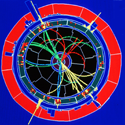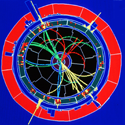Strongly broken symmetry
When the Large Hadron Collider turns on, physicists will use the gathered accelerator data to answer detailed questions about the nature of fundamental particles and the forces between them. Topping the list is the nature of the dynamics responsible for the Higgs mechanism that gives the elementary particles their mass. In a paper in Physical Review Letters, Jared Evans and Markus Luty of the University of California Davis, US, show that if the Higgs mechanism is strongly coupled, it might show up at the LHC in the form of new resonances in the production of the heaviest elementary particles.
At high energies, the standard model unifies electromagnetism and the weak nuclear interaction to yield four force‐carrying bosons: the photon, , , and the . This unification occurs because their interactions are invariant under electroweak symmetry. But a new interaction is needed to explain why this symmetry is broken—that is, why the and have mass, while the photon is massless. If the interaction responsible is weakly coupled, it will show up in the form of a Higgs boson. If it is strongly coupled, the new particles will be heavier and finding signals at LHC will be more challenging.
Evans and Luty propose that resonances in final states involving the heaviest elementary particles, such as and , are a promising signal for strong dynamics in the Higgs sector. These new resonances are predicted to be narrow with masses around , and should be produced in reasonable quantities at LHC. This makes them a potentially valuable way to pin down the dynamics underlying the Higgs mechanism. – David Voss





